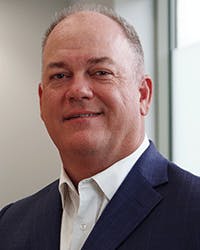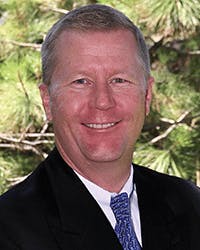Thought Leadership for Today’s Networks.
Learn what our Visionaries have to say about IoT and LPWA technologies, FTTx, supply chain management, 5G Realities, and SDN/NFV and change management.
We asked our ICT Visionaries to consider these questions, and to answer 3 of them. Read the insights of these forward-thinking professionals in this second in a 3-part series.
FTTX
What are the primary pain points providers face today when it comes to fiber? What must change in the way they address their challenges?
IoT and LPWA Technologies
IoT World News (www.iotworldnews.com) says we will soon see the first commercial deployments of new licensed-spectrum low-power wireless access (LPWA) technologies: NB-IoT and LTE-MTC-Cat M1 (LTE-M). LPWA networks offer Internet of Things (IoT) the promise of low-cost, long-battery-life IoT devices that can enable wider-scale IoT deployments. Why is LPWA important, and how quickly will it be a real tool in providers’ toolboxes?
The Evolution of Procurement and Purchasing Processes in Supply Chain Management
Our industry is transforming in ways previously unimagined. Given those changes, have the procurement and product evaluation processes used by service providers changed? If so, how? If not, how should they change? As ICT providers are blending their E&C teams with their IT teams, how will that "marriage" impact the procurement process? And what does that have to do with effective supply chain management?
5G Realities
Long Term Evolution (LTE) networks are firmly established in the US with most mobile subscribers using LTE devices. To meet the increasing demand for mobile bandwidth, especially to support video, the larger mobile operators are in the process of upgrading their LTE networks, and densifying the cellular architecture. The next major iteration of mobile networks will be 5G, due to be deployed sooner than some expected.
AT&T recently announced its 5G Evolution plans for 2017 and beyond. "Our 5G Evolution plans will pave the way to the next-generation of higher speeds for customers. We’re not waiting until the final standards are set to lay the foundation for our evolution to 5G. We’re executing now," said John Donovan, Chief Strategy Officer and Group President, Technology and Operations.
Verizon is also on the 5G deployment path. John Stratton, Verizon EVP and President of Operations, recently shared the carrier’s current move towards fixed wireless commercial trials in 11 markets. They will include both consumers and enterprise customers, which will lay the ground work for actual deployments beginning in 2018.
Though there is much excitement about 5G technology, providers may underestimate the difficulties of taking things from lab environments into the field. Talk about some of the real field challenges 5G faces as these commercial trials commence.
SDN/NFV and Change Management
Tomorrow’s networks need to be highly adaptive to the needs of the services being carried as well as to the needs of the customers being served. As demand for network capacity increases and operators are challenged to maximize the return on their investments, the traditional models of managing the network(s) no longer apply. SDN/NFV can live up to the hype and create an extremely flexible, dynamic and responsive network environment that can provide both operational and cost benefits — if it is done correctly. And it’s not just about technology. Talk about change management and the importance of the human network in this area of change across the ICT landscape.
All Systems Broadband – An Amphenol
Broadband Solutions Company
FTTX
While fiber placement deeper into the access network provides many advantages over time, initial deployment costs often create the greatest challenge to ROI. Perhaps the largest driver of costs is the physical placement of the fiber cable.
At ASB, we have been focusing on solutions that can help reduce costs by developing application-specific products that create value in two ways. One, by removing unnecessary costs associated with initial deployment of the product and, two, by minimizing ongoing costs incurred with product usage.
Of course, the greatest challenge is striking the correct balance between these two items. Solutions designed to allow for "pay as you grow" techniques can limit upfront costs while the business case has time to mature.
The Evolution of Procurement and Purchasing Processes in Supply Chain Management
A large driver of the purchasing process is the development of product specifications. ICT providers seek network reliability through lower cost solutions that provide redundancy, rather than highly customized solutions that may represent a potential failure point.
The challenge in building modern networks mostly revolves around the ideas of scale and redundancy. This creates a need to think about solutions as being grouped, much like the POD concepts discussed in SDN configurations. We are seeing a need for new procurement processes that focus on the agility of products, rather than just their function. Bringing together the E&C and IT teams can help to facilitate this new way of looking at networks, and the purchasing that helps to build them.
Then, with the shift in how electronics are sourced, qualified, and deployed, the need for passive integration solutions is also changing.
Equipment vendors can play a vital role in this process by contributing knowledge about manufacturability, declining component cost curves, etc.
SDN/NFV and Change Management
First and foremost it must be remembered that leadership is key when working with the human network, and will be critical to the implementation of new networks. Experience tells us that major upgrades, which develop higher efficiency through structural changes, typically require a new way of working.
It is critical to embrace the change, and drive the opportunity for human advancement, by creating transition pathways for those willing to move forward. A leader’s ability to recognize these shifting paradigms, and to prepare for them, will yield the greatest results for the ICT provider.
[toggle title=”Biography and Company Profile” load=”hide”]At All Systems Broadband (ASB) – An Amphenol Broadband Solutions Company, Mike sets ASB’s technology vision. His organization is responsible for product innovation along with product roadmaps, product management and business development. Mike has over 25 years of telecommunication experience with an outside plant focus. The first 20 years of experience began at Raychem. Previous roles include product development, product management, and sales.
Email: [email protected]
LinkedIn: https://www.linkedin.com/in/michaelgrice
AT&T
FTTX
Aerial or buried, when building out the fiber connection in a neighborhood, we have a customized route for each connection. There is a lot of diversity in our options to deliver service. Managing cost and maintaining quality is an ongoing opportunity. We constantly look for new technology and designs to make us more efficient in deployment.
Demand for ultra-fast Internet speeds has continually exceeded our expectations. Today, we’re marketing a 1 gigabit connection* on our 100% fiber network to nearly 4 million locations; by mid-2019, we plan to reach at least 12.5 million locations across 67 metro areas with our 100% fiber network. To meet demand, we must decrease cycle time of deployment to deliver faster.
*Actual customer speeds vary. Download speeds are typically 940 Mbps due to overhead capacity reserved to deliver the data.
IoT and LPWA Technologies
Low-Power Wide-Area (LPWA), and in particular LTE-M, will enable a large number of vertical use cases that have historically been either technically or economically challenging to address. This includes enabling Smart Cities (smart water meters, electric meters, etc.), Wearables, or Full/Empty Use cases (storage containers, trash receptacles, etc.). GSMA predicts that LPWA networks, including LTE-M, will surpass 2G, 3G, and 4G connectivity to become the leading IoT technology in 5 years with a total of 1.4 billion connections by 2022.
5G Realities
All of the work starts in our AT&T Labs. This is where we’re laying the foundation for the evolution to a 5G world by pushing the development of our mobile networks forward with industry-leading tests and trials. We currently have 5G lab work operating in 4 major cities: Austin, Texas; Middletown, New Jersey; Atlanta, Georgia; and San Ramon, California. The trials and labs work we’re conducting are helping us guide our 5G 3GPP standards contributions.
We also have active research programs looking at the new software architectures. Across our RAN architecture and 5G lab and field testing work, we’ve worked with about a dozen companies in various proof-of-concept tests and trials for over 2 years. In our proof-of-concept tests, we exposed systems to the challenge of real-world conditions. We tested their performance under the stress of traffic loads, delayed impairments, and transported impairments. All of this work is preparing us for real field challenges, and we expect the knowledge gained to be of critical importance when we begin to rollout future 5G services.
[toggle title=”Biography and Company Profile” load=”hide”]Claudia provides direct support to AT&T President of Technology Operations. Prior to this role, she led a large team including 1,400+ unionized field technicians that provide U-verse video and broadband services across Texas Southwest. Claudia joined AT&T in 1999 through the Leadership Development Program. During her years of service, she has served in numerous business units including network operations, marketing, and human resources.
*Global coverage claim based on offering discounted voice and data roaming; LTE roaming; and voice roaming in more countries than any other U.S. based carrier. International service required. Coverage not available in all areas. Coverage may vary per country and be limited/restricted in some countries. © 2017 AT&T Intellectual Property. All rights reserved.
www.about.att.com
[/toggle]
CenturyLink
FTTX
Costs and time to market increase in municipalities with buried utilities due to traditional trenching, plowing, and boring. Embracing new techniques for micro-trenching and aerial placement will result in more rapid deployment of services. Given the volume of builds, there is a need to work closely with state and municipality permit and inspection departments to look for ways to shorten cycle times and expedite permits. Deployments also require strong modeling teams to ensure all overlay possibilities are uncovered.
Adding enterprise, multi-tenant units, and cell sites increase the investment return on fiber and, as CenturyLink has found, can be used in conjunction with flexible technologies like fiber-fed vectoring or G.fast with FTTP build-out deeper into the wire center in future cycles. One positive is how far fiber quality has increased; bend insensitivity, improved transmission, and the continued evolution of splicing and termination tools, have improved the ecosystem greatly over the last decade.
The Evolution of Procurement and Purchasing Processes in Supply Chain Management
The evolution of ICT solutions has made the blending of E&C and IT a natural next step. Separation between IT and engineering platforms are already beginning to disappear as the network becomes software driven with more commodity-based hardware in both arenas. With the increased scale of coverage and full inclusion of these once siloed vendor partners, supply chains can make more informed decisions around cost and performance, positively impacting both the bottom line and the customer experience.
SDN/NFV and Change Management
SDN/NFV explodes what would have been a discrete router or appliance into underlying physical networks, VMs, and servers, as well as orchestration, analytics, and provisioning systems. The benefits of this, as in CenturyLink’s own virtual BNG on the CORD architecture, are lower costs and increased speed to market for features and services. But with these combinations of code and hardware infrastructure being maintained and updated (sometimes via semi-autonomous mechanisms), the task of managing change can become complex. With this landscape, the job of identifying what is in production, what impacts a change will trigger, and ensuring we reliably notify all impacted internal and external parties, will require new tools and processes. Having a "human network" of SMEs for all the different areas that communicate with each other is essential to managing this environment as the technology matures; more applications roll out, and the technical workforce adapts.
[toggle title=”Biography and Company Profile” load=”hide”]Kristofer is responsible for the reliability and performance of CenturyLink’s nationwide metro Ethernet networks and broadband infrastructure supporting consumer, business, and wholesale customers. Kristofer has been with CenturyLink for 20 years in various Engineering, Planning, and Operations roles and holds a Bachelor’s degree in Mechanical Engineering from the University of Minnesota and a Master’s in Management from the University of Denver, Daniels College of Business.
FTTX
FTTx Network design, and deployment of the "right" technology for your customer can be challenging. MDU, and SFU, in addition to Small/Medium Business customers, all have the same basic needs, faster Internet, voice calling and of course, video (the proverbial Triple Play). Network design with the use of hybrid network deployments will prove to be problematic for providers as the demand for bandwidth increases in the home: scalability will become even more limited with a fiber/copper network design. I see Triple Play changing as time passes, as the consumers of this data decide what they want, when they want it, and how they’re going to get it; providers are going to need to make a very tough decision at some point: Do we continue to provide the channels, or the pipe, or a very expensive both? Consumers may no longer need the channels, they will need a transport through which to receive them directly from the source. As we evolve through this process, scalability has to be in the forefront of our discussions, and we should be building our networks to accommodate the tomorrow’s future, today.
5G Realities
The physical architecture and makeup will need to be able to accommodate the expectations that consumers and enterprise customers alike, are going to require with the anticipation of 5G. Propagation between nodes and cells could greatly affect data transfer rates if not planned and executed effectively. The promises of 5G could potentially mean more small cells are actually needed to either offload the macros or carry the "newly required" data customers are expecting.
SDN/NFV and Change Management
SDN/NFV is a brilliant strategy for providers to look toward, although it may be early to go "all in." Ubiquitous network infrastructure, reducing the high CapEx/OpEx required to maintain, upgrade, and expand the existing "physical layer" sounds like a dream come true. Although always an important part of operations, change management is becoming more of a holistic process map for every person across the organization. As we look forward as an industry, at the migration from brick-and-mortar-housed hardware to the Cloud, all pieces of the puzzle will have to work together in tandem to make these changes happen. Collaboration across functions (and in many organizations, silos) will be essential to be successful.
[toggle title=”Biography and Company Profile” load=”hide”]Sean Flora oversees the OSP construction build initiatives including GPON, VDSL, and Ethernet fiber builds. His team supports Sales, PMO, Engineering, and Construction departments to work together to overcome inevitable obstacles, and keep projects on track. Sean has a diverse background, working across a variety of areas of the Company, and uses this to coach and guide his team to drive success for the Company, employees and customers.
Email: [email protected]
LinkedIn: https://www.linkedin.com/in/sean-flora-cfot-itil-54675586
FTTX
No Pain – No Gain. That’s what my coach used to drill into my head. But following some practical principles of labor management can deliver all the gains of fiber performance while limiting the pain threshold. (Let’s face it: it does require some work.) Most of the cost of deploying and operating a fiber network today is driven by not utilizing skilled labor effectively. With optical fiber widely recognized as the only future-proof methodology for network construction, the availability of skilled technicians is limited. Rather than utilizing the methods of legacy architecture (like my old coach’s instruction), we need to look at new network builds with an eye for optimizing the existing skilled labor only for the most demanding portions of the network. Choose product architectures with modular designs that expand the use of the labor pool with entry-level technicians — significantly lowering the overall cost of deployment while maintaining high-quality construction of the fiber network.
The Evolution of Procurement and Purchasing Processes in Supply Chain Management
Not enough attention is given to the total cost of ownership (TCO) in the selection of products. For example, today about 70% of the cost of delivering fiber to the end user is made up of labor. Many of the old, outdated procurement processes focused too heavily on product costs but, modern day supply chain management teams are shifting to include more analysis of the cost to build the network and to operate the network. Today’s marketplace is one in which service providers need a means to reduce their operating costs and increase their subscriber revenue performance.
5G Realities
The 5G frequencies will require about a hundredfold densification of antennas, along with backhaul capacities in the range of 4-5 Gbps for each small cell location to be able to deliver on the promise of 5G. The reality is that deep fiber deployments will be required to realize the promise of 5G. That is where some of the largest challenges and opportunities exist. But by delivering the most scalable fiber management platform in the industry, inventories are reduced, time to activation is less, and service reliability is improved, since there are fewer SKUs.
[toggle title=”Biography and Company Profile” load=”hide”]Kevin has vast experience in communications technology, fiber optic systems, and business product marketing. He began his career at BellSouth (now AT&T) leading product evaluations of broadband technologies, and also led product management and marketing efforts at ADTRAN for 20 years. He is well known in the industry for his leadership at the FTTH Council. Morgan holds a Bachelor’s in Electrical Engineering (Auburn) and an MBA (Alabama).
Email: [email protected]
Twitter: https://twitter.com/kevinmorgan520
FTTX
My favorite pain point of FTTH is powering the ONT during a power outage. Internet is quickly becoming the item to rely on during an emergency, yet many providers disable Internet during a power outage. I recently read a news article about someone using Facebook to notify authorities of a crime in progress. Could Facebook become the next generation of 911? Landlines are important but many of your customers would prefer the Internet stays up, even if the runtime for the ONT is less. Disabling the Internet during a power outage saves very little ONT runtime. Spring time is severe weather season in Oklahoma. Watching radar on my tablet in real time is paramount! Some service providers charge a few dollars per month to take care of the battery for the customer. Why not enhance that to include Wi-Fi during a power outage? The FCC requirement is the minimum you must provide, and is certainly not the maximum you CAN provide. I challenge the providers to start viewing the battery backup as a service enhancement instead of a pain point.
SDN/NFV and Change Management
We have been progressing towards a self-serve market for years. In the early 1900s, you told the grocer what you wanted and they would gather up the items for you. Today we do that for ourselves not only in the store, but we also do it online. SDN/NFV will further network engineering to a self-serve market. The day is coming that we can simply plug in the new device, watch the network configure itself, and adjust the network traffic accordingly. The advantage to SDN/NFV is automating the software with solutions that can be easily loaded on generic hardware. Think of the potential of an app store for your hardware. Does your customer need a traffic monitoring, firewall, voice, or VPN connectivity? Just download the app. Do your customers need to call you to upgrade service or have you enabled that as a self-serve service?
IoT and LPWA Technologies
Minimizing truck rolls is key to a provider’s bottom line. The IoT devices will help to minimize the number of truck rolls to read a gauge, meter, or battery. The key to long battery life is to compress data, minimize transmission time, and transmission power. The number of sensors available to connect to low-cost microcontrollers has dramatically increased, which will yield truck-roll-minimizing products.
[toggle title=”Biography and Company Profile” load=”hide”]Chris has more than 20 years of telecom engineering experience, and has a passion for powering things. He was instrumental with one of the very first IPTV-over-copper deployments in the US. He was also the 1st MEF CECP engineer in Oklahoma. He holds multiple patents and continues to create innovative ways to power network devices, including the award-winning Voltar solar UPS. He lives in Stillwater, Oklahoma, with his wife Paige and two Westies.
Email: [email protected]
Tel: 806.282.1363
Director – Network Engineering
Frontier Communications
5G Realities
FCC spectrum licensing, antenna placement/ownership, and latency issues are some of the challenges 5G faces in the field. For 5G to be ubiquitous and to meet bandwidth requirements, we must move beyond the 6 Ghz (4G) and make use of the licensed spectrum between 6 Ghz and 60 Ghz. Every neighborhood is different, so installing the required number of antennas will involve numerous site acquisition challenges along with ownership, maintenance, and record-keeping responsibilities. Finally, to address the soft real-time latency requirement of 5G, many core network upgrades and enhancements are required. For the required end-to-end network slicing capability to emerge to reduce latency, computing, control, apps, and services, must be pushed toward a Cloud-based architecture.
SDN/NFV and Change Management
Service providers are looking to these complementary technologies to evolve their networks, and to streamline network operations and provisioning. These benefits could be achieved by removing widespread vendor- and device-specific application program interfaces (APIs) from the network and operations support systems (OSSs), making them more customer and open-application driven. However, the realization of these benefits will be specific to each carrier due to different networks and proprietary legacy systems. In addition, vendors are trying to put their own spin on SDN, leaving 95% standard and 5% "special sauce", which creates differentiation and leads to vendor-specific complexities. These complexities will require skilled network and software coding skill sets to be increased in the Engineering and IT organizations to ensure the evolution and integration of this automation capability is appropriately implemented in each carrier’s infrastructure.
FTTX
Placing techniques over the last 20 years have evolved dramatically, and many economical options are available. However, the push to bury utilities has made right-of-ways more congested. In the rush, it’s important to remember that how you bury cable is as important as where you bury it. Coordination among all right-of-way users is critical to the efficient deployment and long-term integrity of fiber and other utilities. Frontier’s engineers take extra time to determine proper sizing and placement of cable to ensure undisturbed longevity of the OSP fiber network.
[toggle title=”Biography and Company Profile” load=”hide”]As Director of Network Engineering, Diane is part of the team responsible for the implementation and FCC reporting of the Connect America Funding build for Frontier’s 29 states, as well as leads the Fiber-to-the-Cell build team. She is also responsible for managing acquisition-related projects to ensure Frontier meets their obligations associated with its most recent purchase of properties in California, Florida, and Texas. Diane has over 25 years of telecommunication experience in Engineering and Project Management.
FTTX
One primary pain point facing service providers will be dealing with the tremendous strain ubiquitous fiber places on existing fiber management and connectivity solutions. High port count fiber terminations and highly densified fiber distribution points require creative solutions which will give service providers the flexibility to manage and reconfigure their networks in a cost-effective manner. While there has undoubtedly been abundant innovation in the underlying technologies driving fiber deeper into the network, innovation on the connectivity solutions which gives service providers control of their network has been terribly lacking. HD fiber management solutions must evolve to support this ubiquitous densification. They must enable service providers and data center operators to more efficiently and cost effectively scale and manage their optical networks so as to support the explosive growth in port density. Effective HD connectivity solutions will easily integrate a multitude of different fiber management functions while providing service providers with a highly versatile and reconfigurable platform — platforms which may also serve OSP cabinets, fiber distribution hubs, and other small form factor fiber panels. Such advances in fiber connectivity solutions are available today, and will enable service providers to more efficiently utilize the costly rack space required for deploying and upgrading their networks to support these fabulous new services consumers are eagerly adopting.
IoT and LPWA Technologies
LPWA will enable billions of IoT devices, and will complement existing mobile and fixed wireless technologies. Although IoT devices are likely to be intrinsically low-cost and low-power, the sheer volume of IoT devices will place substantial demands on carrier wireline networks. Highly densified fiber infrastructure will be required to enable wide area reach for ubiquitous, low-power devices. To succeed, MNOs must take a more holistic approach to architecting their wireline networks to support emerging LPWA technologies alongside their existing mobile, C-RAN, and fixed wireless networks. With competing LPWA standards and significant CapEx requirements, MNOs face an uneasy decision on how to seamlessly integrate IoT and M2M use cases into their service portfolio.
The Evolution of Procurement and Purchasing Processes in Supply Chain Management
Service providers need to leverage their supply chain partners to collaborate and co-create solutions which will have a very measureable impact on mission critical challenges. The complexity facing service providers today is much more than one of interoperability in the traditional sense, and more one of coexistence. Truly effective supply chain management builds on mutually rewarding relationships that result in solutions which are timely and targeted.
[toggle title=”Biography and Company Profile” load=”hide”]Michael is responsible for the Connectivity Business Unit. Although an engineer by training, Michael is an accomplished global business development and telecom management executive with a perspective for identifying and growing strategic business opportunities. Most recently, Michael was Managing Director of the Network & Product Integrity Group at Telcordia Technologies.
Email: [email protected]
LinkedIn: https://www.linkedin.com/in/michael-zammit-2183812
The Evolution of Procurement and Purchasing Processes in Supply Chain Management
Instead of supporting the deployment of systems with predictable multiyear time horizons and single-vendor OEM solutions, Supply Chain must now be prepared to support the ever-increasing pace of innovation and work with multivendor solutions.
Some aspects of this new world for Supply Chain include:
• Adaptation from sourcing at the system level, to sourcing at the component level.
• Increased responsibility for securing both hardware and software.
• From a software acquisition perspective, the model is moving from monolithic application development to microservices which supply chain management will have to procure. Remaining current on software updates and revisions will be essential.
These elements require that Supply Chain act as system integrators, or partner with a company that understands both the IT and Network environments, can manage the disparate supply chains, and act as an integrator for them.
IoT and LPWA Technologies
LPWA will enable the next big jump towards a connected world and IoT. Easy to implement and deploy, they will serve a number of vertical markets such as manufacturing, wearables, utilities, and transport. These LPWA networks will support devices requiring lower mobility, low power consumption, long range, low cost, and security. Various analysts anticipate LPWA connections to reach up to 5 billion in 2020 and generate nearly US $1 billion in 2018. With that number of connections in such a short period of time, it will take companies with scale and reach to understand and support the environment.
SDN/NFV and Change Management
The migration from traditional hardware/appliance-centric technology to Cloud-based or virtual technology has forced operators to become solutions integrators. The operators were ill-equipped to fill that role, and lacked the necessary skill sets and resources to meet their customers’ requirements. What has now become clear is that the stakeholders responsible for operating these new networks are faced with a massive redefinition of their service delivery model, thereby requiring network, IT, and architecture, teams to adopt new processes, workflows, and tools, to manage the network within cross-functional teams.
Light Reading summarized SDN/NFV as requiring change at every level: in employee skill sets, process reengineering, and automation. Thus, as networks evolve, so must the capabilities and skill sets of the human network. Only through a robust and comprehensive change management program that includes continuous training can the pace of change be accommodated across the ICT landscape.
[toggle title=”Biography and Company Profile” load=”hide”]Paul focuses on the Telco, Cloud, and Virtualization partner ecosystem. He is tasked to lead sales, strategy, and long-term planning for growth for KGPCo as customers transition to the Cloud and virtualized environment. Paul brings 31 years of experience and leadership in the Telecom sector in sales and operations. Preceding KPGCo, Paul held various positions at TE Connectivity, and at BellSouth Telecommunications in the IT and Network organizations.
FTTX
Theodore Roosevelt said In any moment of decision, the best thing you can do is the right thing. The worst thing you can do is nothing. It was only a few years ago that an 18Kft plan was industry standard design. It consisted of fiber-to-the-node and up to 18,000 feet of copper plant. Already, this approach is outdated and is no longer sustainable. Fiber must be as close to the customer premises as possible. Therein lies the pain point. We must go back to the areas we serve, and lay fiber deeper into the network. The more rural the home, and the more distance between homes, the higher the construction cost. Because fiber is so critical to our customers, we must think future, think fiber, and do the right thing by deploying it deeper. To do so, we continue to evaluate new technologies as well as advocate for more funding support at the federal and local levels.
The Evolution of Procurement and Purchasing Processes in Supply Chain Management
The complexity of service delivery over networks based on emerging technologies which incorporate physical, virtual, and multiple system integrations, demonstrates the need for greater collaboration between these disciplines. The "marriage" or blending of cross-functional teams comprised of engineering, construction, and information technology, has become a natural transition for our industry and here at TDS. It allows us to better utilize data to make informed decisions for long-term growth and success. The benefits include a just-in-time inventory, less waste, and the ability to adapt rapidly.
SDN/NFV and Change Management
The telecom industry has transcended from a physical, simplex network to a logical and virtual network with a design for resiliency and redundancy. Gone are the days of flipping switches, swinging pairs, and updates, without a thorough review of the impact. Today, the depth of integration requires methods of procedures, pre- and post-review, and personnel onsite to ensure a successful change. While we all seek more automation and scripts to care for the system updates, we must also have a human network in place to react to real-time events and analyze the change process. Without a human presence, we place too much risk on potential outages. TDS starts every day reviewing the previous change events. This allows us to create situational awareness and respond quickly to any fallout. While we trust in automation, verification is still the best policy.
[toggle title=”Biography and Company Profile” load=”hide”]Bob Perkins has nearly 35 years of experience in the telecommunications industry. In his current role, Bob oversees ILEC, CLEC, and cable operations for TDS Telecom’s Western Region. He started in the business as a technician in the US Air Force and holds a bachelor’s degree in Business Administration. Bob joined TDS in 1994. When not at work Bob spends time with his wife of 33 years and their 2 daughters (or bass fishing). Bob is passionate about the environment, and leads efforts focused on water quality and appropriate land use.
Email: [email protected]
Design & PlanningVerizon
FTTX
In a word, it is density. Verizon is clearly a leader in optical networking with more than 10 years of experience deploying FTTH/Fios, but it isn’t enough as evidenced by our recent announcement to purchase just over 37 million miles of fiber from Corning in the next 3 years. This new fiber will be used to improve our 4G LTE coverage, speed the deployment of 5G, and deliver high-speed broadband to homes and businesses. While fiber is deployed in every city across the nation today, it has to be augmented to meet the ever-increasing capacity demands in the IoT world.
5G Realities
Verizon is conducting 5G field trials in 11 different locations across the country to fully understand geographical- and market-related challenges for both enterprise and residential applications.
One of the biggest challenges to date has been fiber connectivity. The trials up to now have used Common Public Radio Interfaces (CPRI) protocol, which uses multiple dark fibers to avoid the need for WDM equipment at the radio antenna location. The challenges lie in the number of fibers as well as placing fiber between locations where we haven’t in the past, such as where the baseband units and the 5G antennas are located.
SDN/NFV and Change Management
Verizon is embracing SDN/NFV for all the same reasons others are, but is taking it perhaps a step farther than most by driving change in our Operational Support Systems and our organizational structure, using Agile development procedures to deal with the dynamic nature of our future networks. We feel this is necessary to fully exploit the benefits of SDN/NFV while maintaining the industry’s most reliable network.
[toggle title=”Biography and Company Profile” load=”hide”]Glenn Wellbrock is responsible for the development and deployment of new technologies for both the metro and long haul transport infrastructure. A well-respected presenter on optical technology, Wellbrock holds numerous patents in optical technology and is considered an expert in the field. Prior to his current position, Wellbrock ran the advanced technology lab, established evaluation criteria, and set engineering guidelines for all backbone transport equipment. He has more than 20 years at Verizon.
Windstream
FTTX
The biggest pain points remain cost and time to deploy. It’s not just the fiber, local permitting, and construction, but also the equipment and power required to take fiber and, consequently, services further to the edge. To that end, it means leveraging technologies such as line power to reduce power infrastructure costs and permit lead times. It means leveraging new approaches to how and where splitters are leveraged. It means considering alternatives to pad-and-cabinet infrastructure to faster and smaller solutions such as pole-mounted enclosures. Finally, in some cases, it means looking at solutions such as a fixed wireless, instead of fiber, as a solution to extend reach faster in the scenarios where it makes sense to do so.
IOT AND LPWA TECHNOLOGIES
LPWA should help enable the next phase of IoT growth as devices from meters to connected appliances to consumer wearables continue to expand in a variety of different markets. Some of the challenge at this stage still seems to be which standard will ultimately emerge or perhaps, more likely, which standards will coexist depending on the application. Wireless carriers are certainly driving where some of these standards will go as they enable narrowband applications over their existing frequencies without need of additional hardware. But as with the IoT in general, the trade-off for long battery life and low cost is offset with planning around security complexities for tiny processors. There is much still to solve, but the opportunities are exciting.
SDN/NFV and Change Management
SDN and NFV aren’t simply about the technology and network that drives efficiencies, lower cost, and faster response times, but about how a culture of innovation changes to meet the need. The current model of OEM, Carrier Technology Management and Engineering, IT, and a Third-Party Integrator issuing SOWs and RFPs, with associated LOE responses and costs resulting in a waterfall approach, is giving way to a new paradigm. This requires a continuous development and deployment partnership approach, driven by business user stories, with all parties at the same development table to quickly iterate network development. Testing becomes inherent in this continuous integration, continuous development approach, and ultimately drives greater collaboration and accountability among the human players involved in order that their APIs remain modular, reusable, and relevant for the new and changing services they support.
[toggle title=”Biography and Company Profile” load=”hide”]Karl-Arne "K-A" Hegewald has 17 years telecommunications experience, and supports the power and environmental engineering teams, the colocation engineering team, and the colocation coordination team, at Windstream. Prior to joining Windstream, he supported strategic planning, transport engineering, and engineering project management teams at one of the big 3 carriers.
Email: [email protected]
URL: www.windstream.com
Save
Save
Save
Save
Save
Save
Save
Save
Save
Save
Save
Save
Save
Save
Save
Save
Save
Save
Save
Save
Save




























